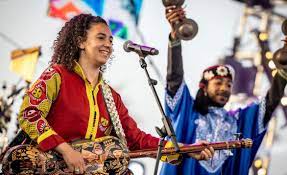Moroccan Women Revolutionize Gnaoua Music
Young Moroccan women are giving the centuries-old art of Gnaoua, a spiritual musical repertoire often reserved for males, a fresh and inclusive vitality. It is also known as “tagnaouite,” and it became well-known all over the globe when UNESCO designated it as intangible cultural heritage in 2019. Asma Hamzaoui, during the Gnaoua World Music Festival in Essaouira, a southern coastal city rich in musical history, questioned, “Why shouldn’t women be part of this dynamic?”
One of the first women to perform Gnaoua, which combines African rhythms with spiritual chants and poetry, is the 26-year-old resident of Casablanca.
She was introduced to the art form at an early age by her father, a Gnaoua master.
The young lady, who in 2012 founded the ensemble “Bnat Timbouktou,” or The Girls of Timbuktu, said that she had been going with her father to his nighttime meetings ever since she was seven years old.
“I eventually mastered the three-stringed camel hide guembri, which I played. Prior to my first solo flight, my father made sure I gained as much knowledge as possible.
The all-female group, which included Hamzaoui on vocals and the guembri in addition to four musicians playing qraqeb steel castanets, astonished festival attendees.
They performed with the Mali-based Amazones d’Afrique, another all-female ensemble.
Fulfills the spirit
“It’s exceptional to have women playing Gnaoua music, which shouldn’t be reserved for men,” said Hamza Tahir, a spectator. “They infuse this music with new life.”
Rising talent Hind Ennaira established her love for tagnaouite in her birthplace of Essaouira after being motivated by Bnat Timbouktou’s success.
Invoking ancestors and spirits in religious melodies, its walled fortress on the Atlantic coast is a birthing place for the mystical musical heritage.
Gnaoua was originally performed by slaves and dates back at least to the 16th century. It has transitioned from being mostly performed in private settings where healing rituals were performed in tandem with the music to public events like concerts and festivals.
Ennaira, who learned to play the guembri from friends, said that Essaouira is the birthplace of tagnaouite. “This lovely legacy nourishes the soul. It’s crucial that young people appreciate it.
By adding a guitarist and drummer to the traditional group, Ennaira gave the custom her unique spin.
They weren’t used to working with a woman, so there were initially some disparities, she said. However, after some difficult training, they acclimated to me and we became closer.
“Jimi Hendrix” fashion
Yousra Mansour, the lead singer of the Gnaoua-rock band Bab L’bluz (“The Blues Gate”), had difficulties breaking into the music industry.
The singer told AFP that she was constrained by two factors: first, the fact that males often work in this sector and second, how we perceive traditional music.
Some of the stricter people don’t really accept it or even tolerate it.
In order to create a kind of “power trio” in the vein of Jimi Hendrix, Mansour said, “we swapped out the bass for the guembri and the guitar for the awisha (a little guembri).
The 32-year-old singer fervently supports the rights of women, lamenting that “as a woman, I have not had an easy life.”
“There weren’t enough women working in this profession. They are wonderful to me when I see Asma Hamzaoui or Hind Ennaira,” she said.
In a world dominated by men, evolution is challenging, but we are beginning to see changes.







